The Automotive Exhaust Manifold Market is estimated to be valued at USD 10.8 billion in 2025 and is projected to reach USD 15.3 billion by 2035, registering a compound annual growth rate (CAGR) of 3.5% over the forecast period.
The Automotive Exhaust Manifold market is experiencing significant growth driven by increasing demand for fuel-efficient and high-performance vehicles. The future outlook for this market is shaped by rising automotive production globally, stricter emission regulations, and advancements in engine technologies that require optimized exhaust systems. Growing consumer preference for vehicles with improved power output, reduced fuel consumption, and lower emissions is fueling the adoption of advanced exhaust manifold designs.
Technological innovations in materials and manufacturing processes have enabled lighter, more durable manifolds that enhance engine efficiency and longevity. Additionally, the expanding automotive aftermarket and replacement demand contribute to the sustained growth of this market.
As vehicle electrification remains gradual, internal combustion engine vehicles continue to dominate production, further supporting the requirement for high-performance exhaust manifolds Increasing government initiatives for cleaner fuels, coupled with rising investments by OEMs in engine optimization, are anticipated to provide long-term growth opportunities in this market.
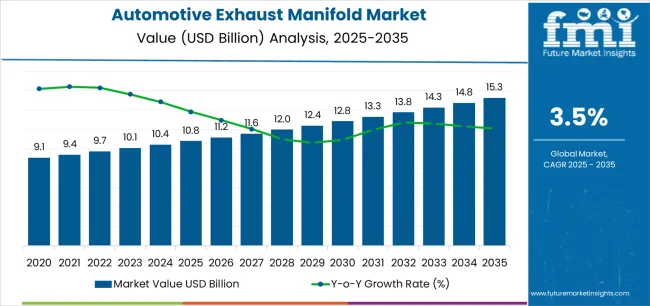
| Metric | Value |
|---|---|
| Automotive Exhaust Manifold Market Estimated Value in (2025 E) | USD 10.8 billion |
| Automotive Exhaust Manifold Market Forecast Value in (2035 F) | USD 15.3 billion |
| Forecast CAGR (2025 to 2035) | 3.5% |
The market is segmented by Product Type, Engine Type, Vehicle Type, Fuel Type, Material Type, and Sales Channel and region. By Product Type, the market is divided into Long Manifolds and Tubular Manifolds. In terms of Engine Type, the market is classified into V Engine and Inline Engine. Based on Vehicle Type, the market is segmented into Passenger Cars, Light Commercial Vehicles, and Heavy Commercial Vehicles. By Fuel Type, the market is divided into Gasoline and Diesel. By Material Type, the market is segmented into Cast Iron and Stainless Steel. By Sales Channel, the market is segmented into Original Equipment Manufacturer and Aftermarket. Regionally, the market is classified into North America, Latin America, Western Europe, Eastern Europe, Balkan & Baltic Countries, Russia & Belarus, Central Asia, East Asia, South Asia & Pacific, and the Middle East & Africa.
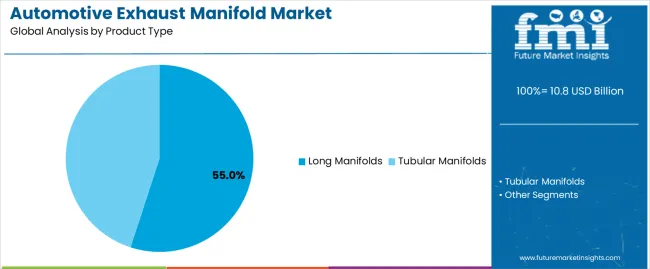
The long manifolds product type is projected to hold 55.0% of the Automotive Exhaust Manifold market revenue share in 2025, making it the leading product type. This dominance is attributed to their ability to improve engine performance by optimizing exhaust flow and enhancing fuel efficiency. The design flexibility of long manifolds allows manufacturers to cater to a wide range of vehicle architectures while maintaining compliance with emission standards.
The segment has benefited from advancements in materials that provide heat resistance and durability under high-temperature conditions. Increasing demand for passenger cars with improved performance metrics has further reinforced the adoption of long manifolds.
Additionally, the ability to reduce engine backpressure and support better torque characteristics has made this product type a preferred choice for both OEMs and the aftermarket The long manifold segment continues to grow due to its compatibility with modern engine designs and the emphasis on performance, efficiency, and regulatory compliance.
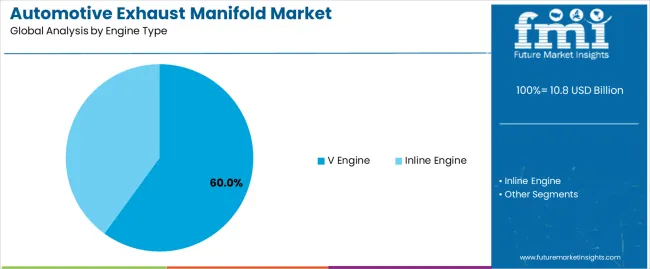
The V engine segment is expected to capture 60.0% of the Automotive Exhaust Manifold market revenue share in 2025, establishing it as the leading engine type. The growth of this segment has been influenced by the increasing production of V-type engines in passenger and commercial vehicles due to their compact design and high power output.
V engines provide better torque characteristics and smoother performance, which necessitates high-quality exhaust manifolds to optimize exhaust flow and maintain fuel efficiency. Manufacturers are increasingly integrating advanced materials and design techniques to handle the thermal and mechanical stresses of V engines, thereby enhancing manifold durability.
Additionally, regulatory pressures for lower emissions have encouraged the adoption of optimized exhaust systems for V engines The segment’s growth is further supported by consumer demand for vehicles that balance performance, efficiency, and compliance with emission standards, making V engines the preferred choice in modern automotive design.
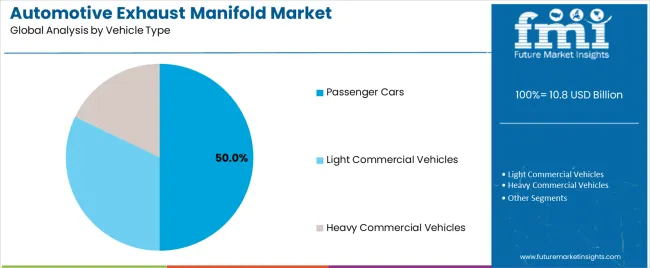
The passenger cars segment is projected to account for 50.0% of the Automotive Exhaust Manifold market revenue in 2025, making it the leading vehicle type. The growth is driven by rising global passenger car production and increasing consumer demand for vehicles with improved fuel efficiency, performance, and reduced emissions.
Exhaust manifolds in passenger cars are designed to optimize engine efficiency and comply with emission norms, which has encouraged manufacturers to invest in advanced manifold designs. The segment has benefited from the increasing focus on lightweight and durable materials that improve engine responsiveness and overall vehicle performance.
Additionally, the expanding passenger car market in emerging economies has contributed to the rising demand for high-quality exhaust manifolds The integration of technology for better thermal management, noise reduction, and emission control further reinforces the dominance of passenger cars in the exhaust manifold market.
The table below presents a comparative assessment of the variation in CAGR over six months for the base year (2025) and current year (2025) for the automotive exhaust manifold sector. This analysis reveals vital shifts in performance and indicates revenue realization patterns, thus providing stakeholders with a better vision of the growth trajectory over the year.
The first half of the year, or H1, spans from January to June. The second half, H2, includes months from July to December. The table below presents the expected CAGR for exhaust manifolds in automobiles over several semi-annual periods spanning from 2025 to 2035. In the first half (H1) of 2025 to 2035, the business is predicted to surge at a CAGR of 3.2, followed by a higher growth rate of 4.2% in the second half (H2) of the same period.
| Particular | Value CAGR |
|---|---|
| H1 | 3.2% (2025 to 2035) |
| H2 | 4.2% (2025 to 2035) |
| H1 | 3.3% (2025 to 2035) |
| H2 | 4.1% (2025 to 2035) |
Moving into the subsequent period, from H1 2025 to H2 2035, the CAGR is projected to increase slightly to 3.3% in the first half and relatively grow to 4.1% in the second half. The primary explanations for this shift in the growth rate include manufacturers' and governments' encouragement for the utilization of alternative fuel cars such as hybrid and electric vehicles, which are significantly more fuel-efficient than traditional ones.
Rising Automotive Production Activities in East Asia to Create Growth Opportunities
Growing fleet in East Asia region presents an opportunity for the replacement of aftermarket automotive exhaust manifolds, which are subjected to ad-hoc and periodic maintenance. Manufacturers are keen on providing innovative automotive technologies to address evolving demands of consumers in the aftermarket segment.
East Asia companies are actively forging strategic partnerships with key entities in the automotive sector. These collaborations facilitate joint research and development efforts, focusing on the creation of advanced and secure automotive exhaust manifold solutions. These partnerships aim to stay ahead of technological innovations, ensuring that manufacturers in East Asia remain leaders in providing better-performing automotive exhaust manifolds.
Advanced Material Technology to Boost Sales of Exhaust Manifolds
Materials used in advanced material technology have high resistance to corrosion and anti-fouling paints. This feature increases the durability and longevity of exhaust manifolds.
Usage of lightweight material leads to lesser energy consumption which enhances the complete performance of the engine. These factors are expected to fuel the sales of automotive exhaust manifolds during the forecast period.
Demand for Clean and Efficient Means of Transport Aiding Growth
Stringent emission norms are compelling manufacturers to produce new automotive exhaust manifolds, which are set to meet the emission norms. Stringent rules for vehicles' tailpipe emissions are directing the manufacturers’ focus toward improved fuel efficiency, which in turn, is expected to fuel growth. The global demand for clean energy is expected to drive growth of efficient exhaust systems in all internal combustion engine vehicles.
Production of Electric Vehicles and High Fuel Prices to Hamper Demand
The United States Department of Energy and California Energy Commission report that 70% of a vehicle's energy is wasted due to engine losses, idling losses, drag, resistance, inertia, sound, and heat. Electric vehicles are significantly more energy-efficient than conventional ones, utilizing around 80% of their energy due to the superior conversion of battery chemical energy into electrical energy.
Presence of the IC engine with the electrical system makes the hybrid vehicle more economical and easy to drive in the city where the traffic is more. Rise of electric vehicles, which eliminate the need for exhaust systems, presents a significant challenge for exhaust manifold manufacturers.
Fuel prices and consumption of petroleum products as fuel in the automotive sector are increasing day by day. Manufacturers and governments are promoting hybrid and electric vehicles to reduce global consumption, which is expected to hinder growth in the forecast period.
The automotive exhaust manifold industry recorded a CAGR of 3.1% during the historical period between 2020 and 2025. The demand for manifolds was positive as it reached a value of USD 10,052 million in 2025 from USD 8,880.9 million in 2020.
The industry has evolved significantly over time due to technological advancements, regulatory changes, and consumer preferences. Before 2020, cast iron was used for exhaust manifolds due to its durability and heat resistance. However, as manufacturers sought to improve fuel efficiency and reduce vehicle weight, lighter materials like stainless steel and aluminum alloys were adopted.
Introduction of stringent emission regulations in North America, Europe, and Asia-Pacific significantly impacted exhaust manifold design, leading to the development of more complex and integrated designs. Advancements in manufacturing processes, such as lost foam casting and precision sand casting, have enabled the production of intricate geometries and enhanced durability.
Integration of turbochargers into exhaust manifolds in automotive engines has significantly enhanced performance and efficiency. Globalization has LED to the diversification of exhaust manifold suppliers and manufacturers across different regions, facilitating the exchange of technology and best practices.
Aftermarket growth has expanded as vehicle customization and performance enhancement gained popularity among enthusiasts during 2020 and 2025. Aftermarket suppliers offer high-performance exhaust manifolds made from specialized materials and featuring optimized designs to meet specific consumer demands.
Emphasis on material innovation, alliances between key companies, and consumer awareness are driving the continuous growth of automotive exhaust manifolds. Demand for exhaust manifolds is set to increase steadily due to their innovative solutions for vehicle emission control, aligning with evolving consumer preferences and new technologies.
Tier 1 companies comprise firms with a revenue of above USD 100 million. These companies are currently capturing a significant share of 40 to 45% of the global industry.
Tier 1 players are mainly known for owning a wide product range and high production capacity. Their extensive expertise in the automotive industry is projected to enable them to attract a large consumer base. Prominent companies within Tier 1 include Faurecia S.A., Tenneco Inc., Eberspächer Group, Benteler International AG, FUTABA INDUSTRIAL CO., LTD., and SANGO Co., Ltd.
Tier 2 companies include mid-size players with revenue of below USD 50 million. These have a considerable presence in specific regions and are highly influencing demand for exhaust manifolds locally. These are characterized by a strong presence overseas and strong industry knowledge.
The companies are growing due to specialized knowledge, product portfolios, and flexibility in meeting demands. Prominent companies in Tier 2 include Katcon, S.A. De C.V., Friedrich Boysen GmbH & Co. KG., DuPont, and others.
The section below covers the analysis of automotive exhaust manifold sales for different countries in several regions of the globe, including the Middle East and Africa, South Asia, Latin America, Western Europe, North America, East Asia, and Eastern Europe. China is anticipated to remain at the forefront in East Asia, with a value share of around 66% in 2035. In South Asia, India is projected to witness a CAGR of 5.1% through 2035.
| Countries | CAGR 2025 to 2035 |
|---|---|
| India | 5.1% |
| China | 4.8% |
| Germany | 4.2% |
| United States | 3.1% |
| Japan | 2.5% |
Sales in China are projected to reach USD 4,185.7 million by 2035. Over the forecast period, demand for exhaust manifolds in the automotive sector within the country is predicted to grow at a 4.8% CAGR.
In 2025, China's automotive industry showcased healthy growth, with passenger car output exceeding 30.16 million units and total sales surpassing 30.09 million units, marking an 11.6% and 12% year-on-year increase, respectively, according to data released by the China Association of Automobile Manufacturers (CAAM).
Key automobile manufacturers and technological pioneers have significantly facilitated the development of automotive exhaust manifold technologies, setting global standards and trends. The United States has seen a noteworthy increase in demand for efficient and intelligent exhaust systems due to consumer demands for improved car performance.
The tech-savvy consumer base is fueling the industry by valuing features such as integrated smart functionalities, smooth exhaust systems, and lower emission requirements. During the forecast period, the United States is projected to surge at a CAGR of 3.1%.
With a strong consumer base, innovative and high-quality production, and a thriving automotive landscape, Japan is the fourth-leading automotive hub in the world. Renowned automakers with a reputation for dependability and cutting-edge technology, such as Nissan, Honda, and Toyota, are based in the country.
Japan's focus on technological advancements in the automotive industry is boosting the positive outlook for exhaust manifold manufacturers. This further creates an opportunity for exhaust manifold manufacturers to develop advanced exhaust systems.
Sale of exhaust manifolds in the automotive sector in the country are anticipated to reach USD 932.3 million by 2035. Over the forecast period, automotive exhaust manifold demand in Japan is set to increase at a robust CAGR of 2.5%.
The section contains information about the leading segments in the exhaust manifold business used in automotive. By material type, the cast iron segment is estimated to grow at a CAGR of 3.3% from 2025 to 2035. Based on vehicle type, the passenger cars segment is anticipated to hold a dominant share and exhibit a CAGR of 4.1% during the forecast period.
| Segment | Cast Iron (Material Type) |
|---|---|
| Value CAGR (2025 to 2035) | 3.3% |
Cast iron exhaust manifolds have key adoption due to the low cost and long durability, which makes these the preferred choice among manufacturers. The automotive industry's demand for high accuracy and productivity, coupled with increased automotive need, is expected to drive growth of the cast iron segment of the automotive exhaust manifold.
The production cost of cast iron is relatively low compared to other materials, further contributing to its popularity among manufacturers. The combination of cost-effectiveness and longevity makes cast iron exhaust manifolds the preferred choice for key automotive manufacturers.
| Segment | Passenger Cars (Vehicle Type) |
|---|---|
| Value CAGR (2025 to 2035) | 4.1% |
GDP growth, rise in disposable income, low interest rates, favorable financing terms, population growth, and global shift toward urban living fuels demand for compact and environmentally friendly passenger cars. Demand for automotive exhaust manifolds made to specifically fit these vehicles' needs is rising along with sale of the passenger cars.
Advanced automotive exhaust manifolds are in high demand in the passenger car segment due in large part to the focus on vehicle emissions. Emissions control and vehicle performance are being addressed by manufacturers by incorporating advanced features into exhaust systems.
The automotive exhaust manifold provides modern solutions for passenger cars in response to consumers' growing awareness of environmental sustainability and vehicle performance. As new automotive technologies emerge, the passenger car segment is frequently an early adopter. Ongoing demand for car exhaust manifolds that enhance and complement the driving experience is partly fueled by this propensity for innovation.
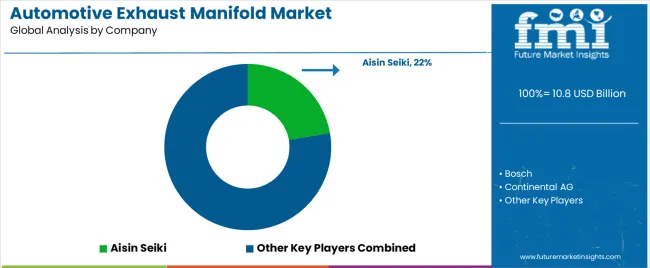
Key companies manufacturing exhaust manifolds moderately consolidate the sector with around 40 to 45% share. Leading companies are prioritizing technological advancements, integrating sustainable practices, and growing their footprints in developing regions. Key companies actively foster collaborations to stay at the forefront of innovation, ensuring exhaust manifolds align with the evolving demands and maintain the highest standards of quality and adaptability.
The sector is fiercely competitive, with leading companies investing in research and development to develop and innovate improved manifold technologies. These superior sensors offer fast response times, high accuracy, and enhanced durability, enabling companies to meet modern emission regulations.
A few companies are focusing on joining hands with local technology providers and start-ups to co-develop innovative products, share expertise, and gain access to niche areas. These companies are also offering rapid technical assistance, training, and customized solutions to cater to varying needs of clients.
Staying at the forefront of technological advancements allows companies to offer competitive products that meet evolving application needs. These partnerships facilitate knowledge sharing, access to new markets, joint research initiatives, and co-development projects.
Industry Updates
Based on product types, the industry is categorized into long and tubular manifolds.
In terms of engine types, the sector is split into a V engine and an inline engine.
By vehicle types, the industry is categorized into passenger cars, light commercial vehicles (LCV), and heavy commercial vehicles (HCV).
As per fuel types, the market is bifurcated into gasoline and diesel.
By material types, the industry is classified into cast iron and stainless steel.
Based on sales channels, exhaust manifolds are segmented into original equipment manufacturer (OEM) and aftermarket.
Regions considered in the study include North America, Latin America, Western Europe, Eastern Europe, East Asia, South Asia and Pacific, and the Middle East and Africa.
The global automotive exhaust manifold market is estimated to be valued at USD 10.8 billion in 2025.
The market size for the automotive exhaust manifold market is projected to reach USD 15.3 billion by 2035.
The automotive exhaust manifold market is expected to grow at a 3.5% CAGR between 2025 and 2035.
The key product types in automotive exhaust manifold market are long manifolds and tubular manifolds.
In terms of engine type, v engine segment to command 60.0% share in the automotive exhaust manifold market in 2025.






Full Research Suite comprises of:
Market outlook & trends analysis
Interviews & case studies
Strategic recommendations
Vendor profiles & capabilities analysis
5-year forecasts
8 regions and 60+ country-level data splits
Market segment data splits
12 months of continuous data updates
DELIVERED AS:
PDF EXCEL ONLINE
Automotive Active Safety System Market Size and Share Forecast Outlook 2025 to 2035
Automotive Diagnostic Scan Tool Market Size and Share Forecast Outlook 2025 to 2035
Automotive Test Equipment Market Size and Share Forecast Outlook 2025 to 2035
Automotive Dynamic Map Data Market Size and Share Forecast Outlook 2025 to 2035
Automotive Green Tires Market Size and Share Forecast Outlook 2025 to 2035
Automotive E-Tailing Market Size and Share Forecast Outlook 2025 to 2035
Automotive Interior Market Forecast Outlook 2025 to 2035
Automotive Key Market Size and Share Forecast Outlook 2025 to 2035
Automotive Appearance Chemical Market Forecast and Outlook 2025 to 2035
Automotive Seating Market Forecast and Outlook 2025 to 2035
Automotive Domain Control Module Market Forecast and Outlook 2025 to 2035
Automotive Remote Diagnostic Market Forecast and Outlook 2025 to 2035
Automotive-grade Inertial Navigation System Market Size and Share Forecast Outlook 2025 to 2035
Automotive Thin IGBT Module Market Size and Share Forecast Outlook 2025 to 2035
Automotive Hydrogen Leak Detection Sensors Market Size and Share Forecast Outlook 2025 to 2035
Automotive Hybrid IGBTs Market Size and Share Forecast Outlook 2025 to 2035
Automotive Electroplating Service Market Size and Share Forecast Outlook 2025 to 2035
Automotive Manufacturing Equipment Market Size and Share Forecast Outlook 2025 to 2035
Automotive Pressure Sensor Market Size and Share Forecast Outlook 2025 to 2035
Automotive Vacuum Brake Booster Market Size and Share Forecast Outlook 2025 to 2035

Thank you!
You will receive an email from our Business Development Manager. Please be sure to check your SPAM/JUNK folder too.
Chat With
MaRIA